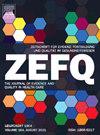尿失禁的物理治疗护理在年龄,性别,护理情况和非正式提供者网络的背景下-纵向德国索赔数据分析。
IF 1.7
Q4 HEALTH POLICY & SERVICES
Zeitschrift fur Evidenz Fortbildung und Qualitaet im Gesundheitswesen
Pub Date : 2025-07-01
DOI:10.1016/j.zefq.2025.05.001
引用次数: 0
摘要
背景:尿失禁影响5%到35%的老年人。除其他外,未经治疗的尿失禁与生活质量下降有关。盆底肌肉训练是一线治疗方法。关于物理治疗护理比例的现有证据仍然有限,特别是关于尿失禁的男性,并且没有充分说明护理情况或年龄特异性差异。本研究调查了物理治疗护理的比例,根据年龄、性别、护理情况、非正式提供者网络和时间趋势进行区分,以解决这些证据差距。方法:我们分析了长达9年(2008年至2016年)的健康保险基金索赔数据,涉及多达6,433,070名65岁以上的人,并应用网络方法来识别患者共享网络。我们以季度为基础计算物理治疗护理的比例。结果:随时间的推移,物理治疗护理的比例保持相对稳定。2016年第一季度,尿失禁发生率为10.5%,无护理者为7.9%,家庭护理者为11.9%,养老院居民为14.0%。85 ~ 89岁无护理的男性尿失禁发生率最低(3.5%),70 ~ 74岁住在养老院的女性尿失禁发生率最高(19.3%)。疗养院中女性和男性患者共享网络之间的物理治疗护理比例差异最大(SD分别为9.7%和9.2%)。结论:这些发现表明,在所有年龄组和护理情况下,对男女物理治疗服务的系统性使用不足。没有护理需求的老年男性尤其面临被滥用的风险。本文章由计算机程序翻译,如有差异,请以英文原文为准。
Physiotherapeutic care for urinary incontinence in the context of age, sex, care situation, and informal provider networks – A longitudinal German claims data analysis
Background
Urinary incontinence affects 5% to 35% of the older adult population. Untreated urinary incontinence is associated with reduced quality of life, amongst others. Pelvic floor muscle training is the first-line treatment. Existing evidence on the proportion of physiotherapy care remains limited, particularly regarding men with urinary incontinence, and insufficiently accounts for care situation- or age-specific disparities. This study investigated the proportion of physiotherapy care, differentiated by age, sex, care situation, informal provider networks, and temporal trends, to address these evidence gaps.
Method
We analysed health insurance fund claims data covering a period of 9 years (2008–2016), from up to 6,433,070 individuals aged 65+, and applied a network approach to identify patient sharing networks. We calculated the proportion of physiotherapy care on a quarterly basis.
Results
The proportion of physiotherapy care remained relatively stable over time. In the first quarter of 2016, it was 10.5% for people with incident urinary incontinence in total, 7.9% for those without care, 11.9% for people with home care, and 14.0% for nursing home residents. The lowest proportion of physiotherapy care (3.5%) was found among men with incident urinary incontinence in the 85 to 89 age group receiving no care, and the highest proportion (19.3%) among women with incident urinary incontinence in the age group 70 to 74 years living in a nursing home. The variation in the proportion of physiotherapy care between patient sharing networks was the highest for women and men in nursing homes (SD 9.7% and 9.2%, respectively).
Conclusions
These findings indicate a systematic underuse of physiotherapy services for both sexes across all age groups and care situations. Older men without care needs are particularly at risk for underuse.
求助全文
通过发布文献求助,成功后即可免费获取论文全文。
去求助
来源期刊

Zeitschrift fur Evidenz Fortbildung und Qualitaet im Gesundheitswesen
HEALTH POLICY & SERVICES-
CiteScore
1.90
自引率
18.20%
发文量
129
 求助内容:
求助内容: 应助结果提醒方式:
应助结果提醒方式:


